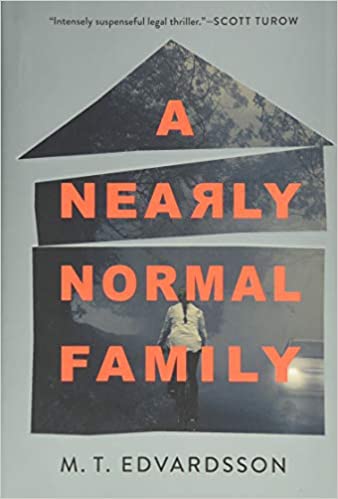
Crime or legal thrillers, which I rarely read, are written to be exciting and to keep you the reader guessing who the perpetrator is or, if she’s identified early in the story, whether she is in fact guilty. Crime thriller, I think, is one genre in which the plot is primary. Characterization may not be well-rounded and it focuses on what motivates a crime. How thrilling the story becomes for you depends on clues, including clever and imaginative red herrings, the writer throws at you to keep you guessing until the “truth” is revealed.
But is the truth ever really revealed? When the suspense is at a high pitch, is the truth even important?
I’m one of those readers who prefer crime thrillers to do more than keep me on the edge of my seat. A Nearly Normal Family, set in Sweden, by MT Edvardsson succeeds in doing that. In the first place, the narrative veers away from building up events around the crime. But what it may lack in suspense is made up for by what it offers.
The novel’s most compelling feature for me is how Edvardsson has structured his storytelling. He borrows a device from the classic film masterpiece Rashomon, written and directed by Japanese film master Akira Kurosawa. If you’re a move buff, you’ll remember that the murder and rape episode at the heart of Rashomon is told from the different perspectives of people who might have witnessed or been involved in at least some parts of what actually happened during or around the time it occurred. Edvardsson tells his story of a murder (which we learn later on also includes rape) from the viewpoints of the mother, father, and daughter (the accused ) of one family.
Though the father asserts his family is typical or ordinary, his daughter Stella gives the impression of having an antisocial personality (if not psychopathic) disorder. It’s possible though that how she behaves might be a reaction to her moralistic father. But if her self-perception represents who she really is, that fact alone disqualifies this family from the “ordinary” category. Less than 5% of the adult population, according to studies, have an antisocial disorder.
Stella’s psychopathic tendencies as well as her history as a crime victim make her culpability probable. But she doesn’t confess to the murder. So is she, in fact, the perpetrator?

Right away, the Rashomon style raises the question: Which of the stories or a combination of them represent the truth? More than that, we see that not only are perceptions fallible but also that the most upright of witnesses will lie, distort, or withhold testimony to save themselves or their loved-ones (the pastor-father lies; the lawyer-mother throws evidence and helps orchestrate the testimony of an important witness). We also see, as many already know, that the “reasonable doubt” criterion in determining guilt in a court of law is not after the truth, i.e., what in fact happened. You don’t get “the truth, the whole truth, and nothing but the truth” from the witnesses. Further, the jury that passes judgement on guilt are, after all, also ordinary people with flawed and self-serving perceptions.
This novel is less a nail-biting suspense about a serious crime than it is a family drama about how a family gets mired in the aftermath of the crime and what each parent does to help their daughter. As such, it’s quite absorbing. And to the author’s credit, the family drama never stops you from wondering: Did she or didn’t she?
In the end, you learn the facts of the crime directly from the perpetrator. I would have felt cheated and found the story less satisfying if this part were left out.

